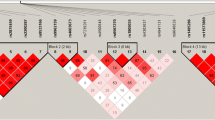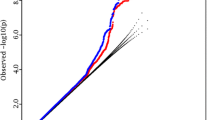Abstract
Femoral neck compression strength index (fCSI), a novel phenotypic parameter that integrates bone density, bone size, and body size, has significant potential to improve hip fracture risk assessment. The genetic factors underlying variations in fCSI, however, remain largely unknown. Given the important roles of the receptor activator of the nuclear factor-κB ligand/receptor activator of the nuclear factor-κB/osteoprotegerin (RANKL/RANK/OPG) pathway in the regulation of bone remodeling, we tested the associations between RANKL/RANK/OPG polymorphisms and variations in fCSI as well as its components (femoral neck bone mineral density [fBMD], femoral neck width [FNW], and weight). This was accomplished with a sample comprising 1873 subjects from 405 Caucasian nuclear families. Of the 37 total SNPs studied in these three genes, 3 SNPs, namely, rs12585014, rs7988338, and rs2148073, of RANKL were significantly associated with fCSI (P = 0.0007, 0.0007, and 0.0005, respectively) after conservative Bonferroni correction. Moreover, the three SNPs were approximately in complete linkage disequilibrium. Haplotype-based association tests corroborated the single-SNP results since haplotype 1 of block 1 of the RANKL gene achieved an even more significant association with fCSI (P = 0.0003) than any of the individual SNPs. However, we did not detect any significant associations of these genes with fBMD, FNW, or weight. In summary, our findings suggest that the RANKL gene may play an important role in variation in fCSI, independent of fBMD and non-fBMD components.

Similar content being viewed by others
References
Cooper C, Campion G, Melton LJIII (1992) Hip fractures in the elderly: a world-wide projection. Osteoporos Int 2:285–289
Melton LJIII, Atkinson EJ, O’Fallon WM, Wahner HW, Riggs BL (1993) Long-term fracture prediction by bone mineral assessed at different skeletal sites. J Bone Miner Res 8:1227–1233
Johnell O, Kanis JA, Oden A, Johansson H, De Laet C, Delmas P, Eisman JA, Fujiwara S, Kroger H, Mellstrom D, Meunier PJ, Melton LJIII, O’Neill T, Pols H, Reeve J, Silman A, Tenenhouse A (2005) Predictive value of BMD for hip and other fractures. J Bone Miner Res 20:1185–1194
Stone KL, Seeley DG, Lui LY, Cauley JA, Ensrud K, Browner WS, Nevitt MC, Cummings SR (2003) BMD at multiple sites and risk of fracture of multiple types: long-term results from the Study of Osteoporotic Fractures. J Bone Miner Res 18:1947–1954
Allolio B (1999) Risk factors for hip fracture not related to bone mass and their therapeutic implications. Osteoporos Int 9(Suppl 2):S9–S16
Cordey J, Schneider M, Belendez C, Ziegler WJ, Rahn BA, Perren SM (1992) Effect of bone size, not density, on the stiffness of the proximal part of normal and osteoporotic human femora. J Bone Miner Res 7(Suppl 2):S437–S444
Dalen N, Hellstrom LG, Jacobson B (1976) Bone mineral content and mechanical strength of the femoral neck. Acta Orthop Scand 47:503–508
Hayes WC, Myers ER, Morris JN, Gerhart TN, Yett HS, Lipsitz LA (1993) Impact near the hip dominates fracture risk in elderly nursing home residents who fall. Calcif Tissue Int 52:192–198
Robinovitch SN, Hayes WC, McMahon TA (1991) Prediction of femoral impact forces in falls on the hip. J Biomech Eng 113:366–374
Ensrud KE, Lipschutz RC, Cauley JA, Seeley D, Nevitt MC, Scott J, Orwoll ES, Genant HK, Cummings SR (1997) Body size and hip fracture risk in older women: a prospective study. Study of Osteoporotic Fractures Research Group. Am J Med 103:274–280
Karlamangla AS, Barrett-Connor E, Young J, Greendale GA (2004) Hip fracture risk assessment using composite indices of femoral neck strength: the Rancho Bernardo study. Osteoporos Int 15:62–70
Baud’huin M, Duplomb L, Ruiz Velasco C, Fortun Y, Heymann D, Padrines M (2007) Key roles of the OPG-RANK-RANKL system in bone oncology. Expert Rev Anticancer Ther 7:221–232
Boyce BF, **ng L (2007) Biology of RANK, RANKL, and osteoprotegerin. Arthritis Res Ther 9(Suppl 1):S1
Boyce BF, **ng L (2007) The RANKL/RANK/OPG pathway. Curr Osteoporos Rep 5:98–104
Wittrant Y, Theoleyre S, Chipoy C, Padrines M, Blanchard F, Heymann D, Redini F (2004) RANKL/RANK/OPG: new therapeutic targets in bone tumours and associated osteolysis. Biochim Biophys Acta 1704:49–57
Boyce BF, **ng L (2008) Functions of RANKL/RANK/OPG in bone modeling and remodeling. Arch Biochem Biophys 473:139–146
Koh JM, Park BL, Kim DJ, Kim GS, Cheong HS, Kim TH, Hong JM, Shin HI, Park EK, Kim SY, Shin HD (2007) Identification of novel RANK polymorphisms and their putative association with low BMD among postmenopausal women. Osteoporos Int 18:323–331
Kim JG, Kim JH, Kim JY, Ku SY, Jee BC, Suh CS, Kim SH, Choi YM (2007) Association between osteoprotegerin (OPG), receptor activator of nuclear factor-kappaB (RANK), and RANK ligand (RANKL) gene polymorphisms and circulating OPG, soluble RANKL levels, and bone mineral density in Korean postmenopausal women. Menopause 14:913–918
Brandstrom H, Gerdhem P, Stiger F, Obrant KJ, Melhus H, Ljunggren O, Kindmark A, Akesson K (2004) Single nucleotide polymorphisms in the human gene for osteoprotegerin are not related to bone mineral density or fracture in elderly women. Calcif Tissue Int 74:18–24
Mencej S, Prezelj J, Kocijancic A, Ostanek B, Marc J (2006) Association of TNFSF11 gene promoter polymorphisms with bone mineral density in postmenopausal women. Maturitas 55:219–226
**ong DH, Liu YZ, Liu PY, Zhao LJ, Deng HW (2005) Association analysis of estrogen receptor alpha gene polymorphisms with cross-sectional geometry of the femoral neck in Caucasian nuclear families. Osteoporos Int 16:2113–2122
Beck T (2003) Measuring the structural strength of bones with dual-energy X-ray absorptiometry: principles, technical limitations, and future possibilities. Osteoporos Int 14(Suppl 5):S81–S88
Genant HK (1995) Universal standardization for dual X-ray absorptiometry: patient and phantom cross-calibration results. J Bone Miner Res 10:997–998
O’Connell JR, Weeks DE (1998) PedCheck: a program for identification of genotype incompatibilities in linkage analysis. Am J Hum Genet 63:259–266
Abecasis GR, Cherny SS, Cookson WO, Cardon LR (2002) Merlin—rapid analysis of dense genetic maps using sparse gene flow trees. Nat Genet 30:97–101
Stephens M, Scheet P (2005) Accounting for decay of linkage disequilibrium in haplotype inference and missing-data imputation. Am J Hum Genet 76:449–462
Li J, Jiang T (2005) Computing the minimum recombinant haplotype configuration from incomplete genotype data on a pedigree by integer linear programming. J Comput Biol 12:719–739
**ao P, Liu PY, Lu Y, Guo YF, **ong DH, Li LH, Recker RR, Deng HW (2005) Association tests of interleukin-6 (IL-6) and type II tumor necrosis factor receptor (TNFR2) genes with bone mineral density in Caucasians using a re-sampling approach. Hum Genet 117:340–348
Zhang YY, Liu PY, Deng HW (2003) The impact of reproductive and menstrual history on bone mineral density in Chinese women. J Clin Densitom 6:289–296
Duan Y, Beck TJ, Wang XF, Seeman E (2003) Structural and biomechanical basis of sexual dimorphism in femoral neck fragility has its origins in growth and aging. J Bone Miner Res 18:1766–1774
Rivadeneira F, Houwing-Duistermaat JJ, Beck TJ, Janssen JA, Hofman A, Pols HA, Van Duijn CM, Uitterlinden AG (2004) The influence of an insulin-like growth factor I gene promoter polymorphism on hip bone geometry and the risk of nonvertebral fracture in the elderly: the Rotterdam Study. J Bone Miner Res 19:1280–1290
Wynne F, Drummond F, O’Sullivan K, Daly M, Shanahan F, Molloy MG, Quane KA (2002) Investigation of the genetic influence of the OPG, VDR (Fok1), and COLIA1 Sp1 polymorphisms on BMD in the Irish population. Calcif Tissue Int 71:26–35
Zhao HY, Liu JM, Ning G, Zhao YJ, Zhang LZ, Sun LH, Xu MY, Uitterlinden AG, Chen JL (2005) The influence of Lys3Asn polymorphism in the osteoprotegerin gene on bone mineral density in Chinese postmenopausal women. Osteoporos Int 16:1519–1524
Vidal C, Brincat M, Xuereb Anastasi A (2006) TNFRSF11B gene variants and bone mineral density in postmenopausal women in Malta. Maturitas 53:386–395
Dincel E, Sepici-Dincel A, Sepici V, Ozsoy H, Sepici B (2008) Hip fracture risk and different gene polymorphisms in the Turkish population. Clinics 63:645–650
Moffett SP, Oakley JI, Cauley JA, Lui LY, Ensrud KE, Taylor BC, Hillier TA, Hochberg MC, Li J, Cayabyab S, Lee JM, Peltz G, Cummings SR, Zmuda JM (2008) Osteoprotegerin Lys3Asn polymorphism and the risk of fracture in older women. J Clin Endocrinol Metab 93:2002–2008
Mencej S, Albagha OM, Prezelj J, Kocjan T, Marc J (2008) Tumour necrosis factor superfamily member 11 gene promoter polymorphisms modulate promoter activity and influence bone mineral density in postmenopausal women with osteoporosis. J Mol Endocrinol 40:273–279
Demissie S, Dupuis J, Cupples LA, Beck TJ, Kiel DP, Karasik D (2007) Proximal hip geometry is linked to several chromosomal regions: genome-wide linkage results from the Framingham Osteoporosis Study. Bone 40:743–750
Perusse L, Chagnon YC, Weisnagel J, Bouchard C (1999) The human obesity gene map: the 1998 update. Obes Res 7:111–129
Eghbali-Fatourechi G, Khosla S, Sanyal A, Boyle WJ, Lacey DL, Riggs BL (2003) Role of RANK ligand in mediating increased bone resorption in early postmenopausal women. J Clin Invest 111:1221–1230
Irdesel J, Ar I (2006) The relationship between the proximal femur morphometry and bone mineral density in Turkish women. Minerva Med 97:153–159
Xu H, Long JR, Yang YJ, Deng FY, Deng HW (2006) Genetic determination and correlation of body weight and body mass index (BMI) and cross-sectional geometric parameters of the femoral neck. Osteoporos Int 17:1602–1607
Harris SS, Dawson-Hughes B (1996) Weight, body composition, and bone density in postmenopausal women. Calcif Tissue Int 59:428–432
Cornier MA, Dabelea D, Hernandez TL, Lindstrom RC, Steig AJ, Stob NR, Van Pelt RE, Wang H, Eckel RH (2008) The metabolic syndrome. Endocr Rev 29:777–822
Lang TF, Keyak JH, Heitz MW, Augat P, Lu Y, Mathur A, Genant HK (1997) Volumetric quantitative computed tomography of the proximal femur: precision and relation to bone strength. Bone 21:101–108
Alonso CG, Curiel MD, Carranza FH, Cano RP, Perez AD (2000) Femoral bone mineral density, neck-shaft angle and mean femoral neck width as predictors of hip fracture in men and women. Multicenter Project for Research in Osteoporosis. Osteoporos Int 11:714–720
Acknowledgments
Investigators of this work were partially supported by grants from the National Institutes of Health (R01AR050496, R21 AG027110, R01 AG026564, P50 AR055081, and R21 AA015973). The study also benefited from grants from the National Science Foundation of China, Huo Ying Dong Education Foundation, HuNan Province, **’an Jiaotong University, and the Ministry of Education of China.
Author information
Authors and Affiliations
Corresponding author
Rights and permissions
About this article
Cite this article
Dong, SS., Liu, XG., Chen, Y. et al. Association Analyses of RANKL/RANK/OPG Gene Polymorphisms with Femoral Neck Compression Strength Index Variation in Caucasians. Calcif Tissue Int 85, 104–112 (2009). https://doi.org/10.1007/s00223-009-9255-5
Received:
Accepted:
Published:
Issue Date:
DOI: https://doi.org/10.1007/s00223-009-9255-5




